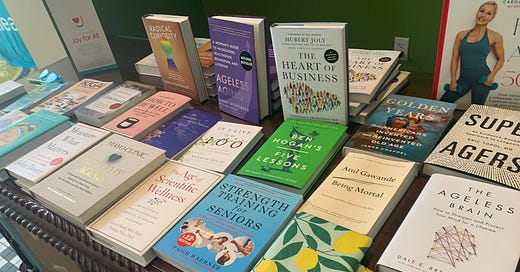10 Takeaways from the Longevity Summit
Simple practices for better sleep, memory, and strength as we age.
Welcome to a newsletter themed at the intersection of longevity and wine history. 🍷
Popular books on display at the “What’s Next Longevity Venture Summit” last week.
Taking steps to improve brain health early and the importance of quality sleep were themes rippling through the What’s Next Longevity Venture Summit held last week in Berkeley, California. Here are 10 impactful things I took away from the three-day event.
1. Widening gap between lifespan vs health span: Health span refers to the years in which a person lives in good health. There is a 12.4 year gap between lifespan and health span, which means people are living longer but more than a decade troubled with disease or disability, according to Laurie Orlov, principal analyst of Aging and Health Technology Watch. (I plan to write more about this in the coming months.)
2. Preventing Alzheimer’s: “The number one fear of aging is getting Alzheimer’s,” said Maddy Dychtwald, co-founder of Age Wave, a consulting and research company. She said for those who want to add healthy years to their lifespan, it’s important to not just eat healthily and exercise, but also strength train to retain muscle mass. It’s also important to maintain your social connections.
Brain Exercises
3. Brain exercises are also critical. You shouldn’t wait until you start to recognize signs of cognitive decline to take action. By then, it’s too late, said Henry Mahncke, CEO of Posit Science. His company created and markets the BrainHQ app, which provides brain training exercises designed to improve cognitive function, including memory, processing speed and attention.
Quality Sleep
4. Good sleep is the key to brain health. That’s according to several conference speakers. Mel Barsky, who leads the Centre for Aging + Brain Health Innovation, said he envisions a day where corporations will promote that they are brain healthy companies, and “Forbes publishes a list of top 50 brain healthy companies to work for,” he said.
5. Have trouble falling asleep? Try the 4-7-8 Breathe Exercise, said Dr. Ryan Kotton, clinical chief at Cedars-Sinai Medical Center and assistant professor at UCLA School of Medicine.
Breathe in for 4 seconds.
Hold for 7 seconds.
Breathe out for 8 seconds.
“Do that 10-15 times and that should help you fall back to sleep,” he said.
Grip Strength
6. Grip strength is a key vital sign. For athletes, it’s important to have a strong grip to improve athletic performance and to help prevent injuries, but it’s just as important in healthy adults. Declining grip strength can predict an increased risk of functional limitations and disability as we get older, according to multiple speakers at the conference.
“Monitoring grip strength is a vital sign to help prevent falls,” said Paul Rinne, co-founder of Able Care, a digital health company on a mission to keep aging seniors at home. “Grip strength is a prime indicator if you can live alone. It should be as common as taking a blood pressure test for seniors.”
7. Improving Grip Strength: Dr. Kotton also talked about the importance of grip strength. Among other things, he said 20 minutes a day of resistance training can have a big impact.
8. Fall Risk Solution: The greatest fear for seniors — besides Alzheimer’s — “is losing their independence,” said Steve Clark, CEO of Briggs Health. A bone-bruising fall in the home is often what triggers a person’s move to an assisted living community. Clark’s company is marketing a “smart hip guardian,” that at-risk people wear like a fanny pack. He says they’ve tested it not just in labs, but with athletes playing soccer and hockey. “[More than] 21,000 perfectly catastrophic falls that would have altered a senior's life, but that our athletic volunteers shook off.”
AI and other tech
9. Behavior in the home will become a vital sign soon. Tools today are built on data collected from in-home sensors. They can combine that data with other personal information, such as health profiles or medication lists, to create a digital twin, said Laurie Orlov. This enables prompt reactions to troubling changes in behavior. It can act as a vital sign for overall wellbeing.
10. Tech-powered in-home pre-care: Prior to the actual need for home care, concerned family members can use in-home technology like ambient sensors, providing a form of pre-care, according to Orlov. This could include check-ins from a nurse but also requests for help with the laundry or help with a bath.
If you’re new here—hi, I’m Kevin!
I’m the author of 🍷 Rain on the Monte Bello Ridge,🍷 my forthcoming memoir about health, aging and winemaking. (Read the origin story of the book.) 🍇
The Centenarian Playbook is my newsletter, which features:
Healthy aging/longevity tips and stories from Grandma Kay’s long life.
Wine history & stories of the Gemello Winery
Ancestry & family research tips
There are three buttons at the bottom of every post: “like,” “comment,” and “restack.” Restacking is sharing in digital form. It goes out to the Substack community. If you enjoy the content and click “Restack,” it helps a lot.





Great tips! Recommend using Therapy Putty 4-pack (x-soft, soft, medium and firm) High-Grade Silicone for hand and grip exercises. https://specialsupplies.com/products/therapy-putty-resistive-hand-exercise-kit-set-of-4-strengths-3oz-each